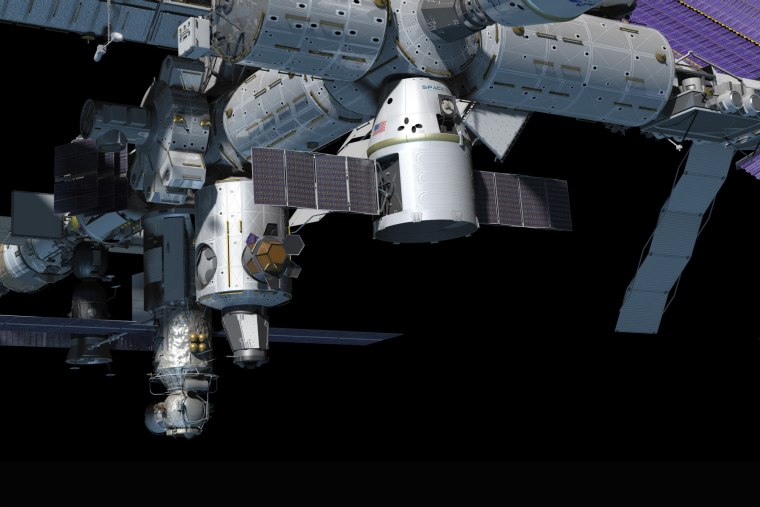As promised, NASA issued the formal invitation on Tuesday for a competition leading to new types of commercial spaceships that could carry astronauts to and from the International Space Station.
Three of the invitees have a multimillion-dollar head start.
NASA expects the final phase of the competition — known as the Commercial Crew Transport Capability program, or CCtCAP — to result in a fleet of commercial spacecraft that are certified to transport crew by 2017. The space agency would prefer to have more than one provider for those transport services, but that might depend on how much funding is available.
The timetable and resources available for commercial spaceships are key sticking points that are left unresolved in Tuesday's request for proposals. Last week, NASA Administrator Charles Bolden called on Congress to provide the full $821 million requested for the current fiscal year "to keep us on track to begin these launches in 2017." Congress, however, has proposed spending hundreds of millions of dollars less.
Building on earlier phases
During earlier phases of the competition, NASA committed itself to spending more than a billion dollars to support the development of crew-capable space transport systems by three companies: SpaceX, the Boeing Co. and Sierra Nevada Corp. Those same three companies have already been granted about $10 million each for Phase 1 of the CCtCAP certification process, which focuses on flight safety and performance requirements.

In Tuesday's documents, NASA said Phase 2 of the process would be open to all comers — but first they'd have to demonstrate that they measured up to the requirements for Phase 1. NASA said applications for Phase 2 funding should be submitted by Jan. 22. The agency expects to award one or more contracts by next September.
NASA said the requirements for certification will include at least one crewed test flight to the International Space Station. That suggests that the first people to arrive at the station aboard the new spaceships would be private-sector test pilots rather than NASA astronauts. The contracts would also call for "at least two and as many as six crewed, post-certification missions to enable NASA to meet its station crew rotation requirements," the agency said in a news release.
The concept behind the commercial crew program is that the cost of buying services more cheaply from private-sector providers would be less than the cost of operating a new governmental fleet of spaceships.
That's the way it's worked out for cargo deliveries to the space station: SpaceX and Orbital Sciences Corp., for example, won contracts to fly 20 robotic resupply flights for $3.5 billion. The cost averages out to $175 million per flight — which is less than the space shuttle program's cost of $847 million to $1.5 billion per flight (depending on how you count the costs).
Currently, NASA has to fly its astronauts on the three-seat Russian Soyuz spacecraft, at a cost that's due to rise beyond $70 million per seat by 2016. That price tag effectively translates into a cost of $210 million per flight, although it's dicey to delve too deeply into the economics of the Russian space program.
Seeking safety and value
"NASA is committed to launching American astronauts from U.S. soil in the very near future, and we're taking a significant step toward achieving that goal today," NASA Administrator Charles Bolden said in the news release. "Our American industry partners have already proven they can safely and reliably launch supplies to the space station, and now we're working with them to get our crews there as well. However, we will require that these companies provide spacecraft that meet the same rigorous safety standards we had for the space shuttle program, while providing good value to the American taxpayer."
The U.S. companies chosen to fly NASA astronauts would be free to market space transport services to other customers as well.
At the same time that NASA is turning over space station transport services to commercial providers, it's also developing a more powerful launch system to send astronauts beyond low Earth orbit. That system will rely on a heavy-lift Space Launch System rocket, also known as SLS, and a new type of crew capsule called Orion. The development costs for that system are projected to amount to more than $30 billion, with the first crewed flight scheduled in 2021.
More about new spaceships:
- Debut test flight looms for Orion
- Huge NASA rocket passes design milestone
- NASA passes torch for space commercialization
- NBC archive on the commercial space race
Alan Boyle is NBCNews.com's science editor. Connect with the Cosmic Log community by "liking" the log's Facebook page, following @b0yle on Twitter and adding the Cosmic Log page to your Google+ presence. To keep up with Cosmic Log as well as NBCNews.com's other stories about science and space, sign up for the Tech & Science newsletter, delivered to your email in-box every weekday. You can also check out "The Case for Pluto," my book about the controversial dwarf planet and the search for new worlds.